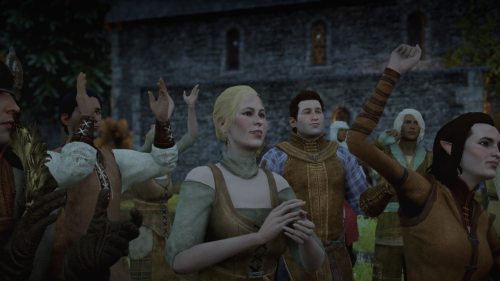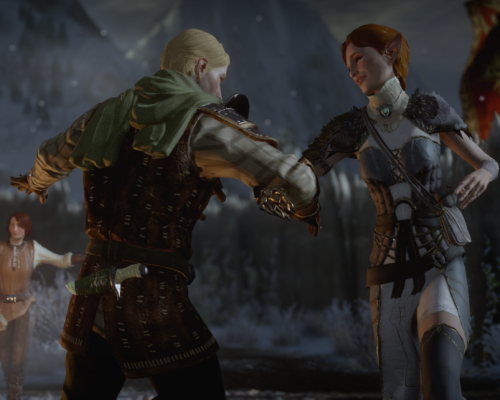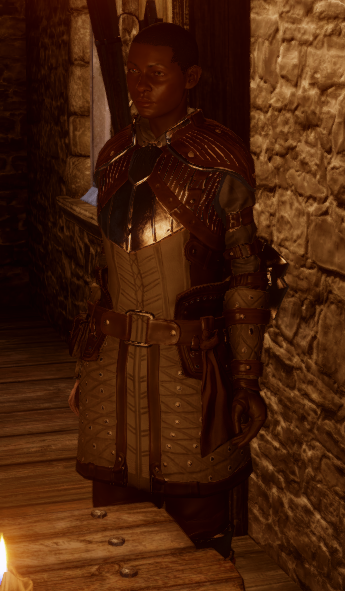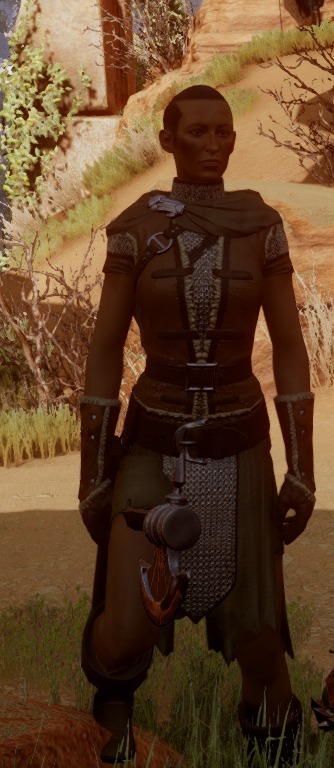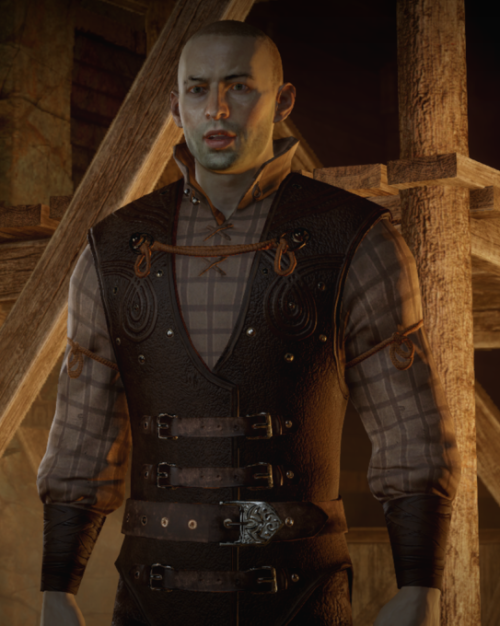Highever
How much canon info is there about Highever? I haven't been able to find much apart from: It has an alienage, is by the coast and makes a signature kind of cloth (wool industry?). How big is the city? Is it near/around Castle Cousland? Does it have a harbour? How big is the alienage and what is it like?
(Alright, for you I’m going to make this into an official lore post, because this is actually small and specific).
Disclaimer: All of this is completely canonical knowledge. Nothing headcanoned, there are sources for it and I’ve gathered from every source that I could. This includes: Codice (Highever, Construction Report: Brickmarks, ), Dragon Age Origins Ultimate/Collector’s Edition Prima Guide, Dragon AGE Core Rulebook. Nothing is headcanon and nothing is taken from an unreliable sources (i.e. Wikipedia).
Highever
Location
Highever is a Teyrnir in northern Thedas, one of the few that set on the Coastlands. It sets on the coast of the Waking Sea, west of Amaranthine, across the sea from Kirkwall and the Vimmark Mountains, and North of The Bannorn.

In the very center of the Highever Teyrnir, is Harper’s Ford, this area used to belong to the Howes of Amaranthine. However, during the Orlesian Occupation, Tarleton Howe sided with the Orlesians, Harper’s Ford was marched upon by the Couslands and Howe hung.
Highever is the name of a village in the Teyrnir along the coast, as well as being the name of the Teyrnir (all lands, holdings, and bannorns within in area).
Castle Cousland is located in the Highever Teyrnir, the exact location is unknown.
Highever possesses an Alienage, though the location of it is unknown.
There was a Silver Temple in Highever where Andraste’s Ashes were first held, before being moved to a secret location. Whether the Temple still stands in unknown.
History
In -165 Ancient, Andraste’s “sons” (Maferath’s sons were adopted by Andraste, though many tried to claim to be her birth son in order to earn leadership of the Alamarri tribes) sought to steal Andraste’s ashes from Highever’s Silver Temple and strengthen their claim to Chief of the Alamarri. The ashes were moved to Haven, but the location was never revealed and eventually lost.
Castle Highever, eventually known as Castle Cousland, was built in the Divine Age and was considered no more than an outpost to the Amaranthine Bannorn. The oupost was held by the cousins of the Howes, the Elstans until the Tower Age.
In the Age of Towers, Bann Conobar Elstan was murdered by his wife, Flemeth, leaving no heir behind. Cononbar’s Captain, Sarim Cousland, stepped up and took the land instead.
The Couslands would declare themselves an independent Bannorn from Amaranthine and start a 30 year war, until Highever was freed and owned southwest Amaranthine as well.
It wasn’t until the Black Age that Highever would be named a Teynir under Haelia Cousland, who would unite the nearby lords against the werewolves and earn herself the title along with their fealty.
4:80 Black, Orlais tried to take Highever in hopes to conquer Ferelden, in the first Orlesian Invasion. They would use Highever to supply their troops by sea. However, Redcliffe stood strong against the Invasion and Orlesian was forced to retreat, unable to pass into Highever.
During the Exalted Age, Eletha Cousland would fight Ferelden’s future king, Calenhad, to remain independent. She would lose, but Highever would remain one of two Teynirs and Eletha would remain their teyrna.
However, in the Dragon Age, the Couslands would be betrayed and Castle Cousland would be stormed by Arl Howes forces, the Cousland family almost completely wiped out. The only to survive would Fergus Cousland, who would be lost in the Korcari Wilds until after the Fifth Blight ended.
(Conditional: The youngest Cousland would also survive the attack and go on to become a Grey Warden, swearing vengeance on Howe.)
Highever would be relinquished after Howe’s death by the Warden and returned to the Couslands.
Fergus Cousland is the current Teyrn of Highever.
Heraldry

Highever has two major Heraldry, The Cousland Heraldry (Left) and The Highever Heraldy (Right).
Known People from Highever
Ardal Cousland (A knight/soldier to King Vanedrin Theirin)
Bryce Cousland
Calenhad Theirin
Duncan
Fergus Cousland
Flemeth
Helena (Jory’s Wife)
Oren Cousland
Riordan
Roderick Gilmore
Ser Eryhn (A Templar woman with unmatched grace with a sword and shield)
Warden Cousland
Facts
Highever has a population of 20,000.
Highever has given Ferelden the most famous Alamarri Legends so far (Calenhad, and Flemeth)
Nelaros’ Wedding Ring was forged in Highever, it is also where Tabris’ bride/groom comes from.
Sarethia is the Hahren of Highever’s Alienage.
Warpaint of the Tempest, is the traditional kaddis for mabari in Highever.
Highever Weave is most likely a cloth originating from Highever and may be an export.
Skyhold has bricks stolen from Highever, apparently before the First Orlesian Invasion.
More Posts from Worlds-of-thedas and Others

my best friend varric dragon age
no but how popular are maryden’s songs?? i know she’s playing in every tavern we go to but that could be a conveniently identical npc because inquisition didn’t have a ton of models lol
like what kind of notoriety does Scout Lace Harding have? is rook going to feel like they’re meeting, idk, billie jean. eleanor rigby. jolene herself


Now THIS is the biggest glow-up in Dragon Age history
what is the walls of darkrown made of? wood?
Dragon Age NPC Ages in DA: The Veilguard
This assumes that the 9 years between Dragon Age Inquisition and Dragon Age: The Veilguard refer to the Trespasser DLC (as in the last time Varric would have seen Solas), versus the start of Dragon Age Inquisition. This places DAV in 9:53. Characters who showed up in a previous game will not be repeated in the lists for later games they also appeared in (i.e., Leliana is under DAO, not DAI).
Read more for length & spoiler reasons. The ages listed are assuming they have not had their birthday in 9:53 yet.
Dragon Age: Origins - 9:30 - 23 years prior
Alistair Theirin - 42
Morrigan - 48
Leliana - 49
Zevran Arainai - 47
Oghren Kondrat - 65
Wynne - RIP (would've been 70)
Shale - Eternal
Sten (now Arishok) - 66
Loghain Mac Tir - 74
Anora Mac Tir - 49
Dragon Age: Awakening - 9:31 - 22 years prior
Nathaniel Howe - 52
Anders - 53
Sigrun - 47
Velanna - 47
Dragon Age 2 - 9:30-9:37 - 23-16 years prior
Hawke - 47
Carver/Bethany Hawke - 42
Fenris - ~53
Isabela - 53
Merrill - ~46
Sebastian Vael - 45
Aveline Vallen - ~58
Varric Tethras - 52
Dragon Age Inquisition - 9:41-9:44 - 12-9 years prior
Josephine Montilyet - 40
Cullen Rutherford - 41
Cassandra Pentaghast - 49
Solas - ~2000 (appears mid-40s)
Sera - 31
Vivienne de Fer - 56
Blackwall/Thom Rainier - 57
the Iron Bull - 49
Dorian Pavus - 41
Cole - Ageless (appears 20, or he may have aged into his 30s if he were made more human in DAI)
Kieran - 21
One of the craziest things about Dragon Age (and this might help those of you who don’t go here kind of understand what people are yelling about in the coming months) is its lore. But I don’t mean that in the way you’re probably thinking.
I mean, quite literally, the way it presents its lore to you. In picking up notes and books as you go along and sifting through the codex, the game effectively asks you to act as an anthropologist. You’re met with a host of primary and secondary sources, some many hundreds of years apart from one another, written by anyone from the highest Chantry scholar to John Farmer, and you’re meant to constantly be questioning every piece of information you’re given. What biases are present in what I’m reading? What is fact and what is complete fabrication and what is, potentially, a slightly twisted version of a fact? How does one source potentially contradict another? The lore is one giant mystery-puzzle that you get to piece together across three games, and what conclusions you draw are going to be entirely different from someone else’s, and so on.
And yet, the series still does something even cooler than any of that. You realize, at a certain point, that this idea you have been engaging with on a meta-level — this idea that history is biased and fallible, that it’s written by colonizers and conquerers, genocidal racists and religious zealots, that the ability to control historical narrative is the prize you win for spilling the most blood — that idea is one of, if not perhaps THE most important, overarching theme of the series. The way that we remember history — what we remember and what we don’t, and why — and the impact that has on people on a sociological, political, cultural and psychological level, on both a macro and micro scale. It’s the entire thesis of the series’ main villain’s whole motivation.
And there’s gonna be a lot of people that don’t care about all that but me personally it makes me want to gnaw on a cinder block and scratch at my walls
Dalish Political Opinions:
I've been working on worldbuilding regarding Dalish culture and beliefs, as a framework for writing stories more focused on Dalish characters and clans. This is a rough draft of what different clans might believe and practice, and how those attitudes could differ.
The Future Homeland:
Building a Neo-Arlathan: The great city should rise again, as the jewel of the Dalish culture. We'll benefit most from having a single, large city with strong defenses and room for the clans to overwinter.
Reclaiming the Dales: The Dales should be ours. We should have a wide range of settlements from tiny homesteads to a capital city, dispersed and defended so that we can never loss everything in a single siege.
Founding a Third Kingdom: We need to find a new place to live and build a kingdom, bringing the best of Arlathan and the Dales to a fresh slate.
Nomadic Life: the Dalish are best served by continuing to be nomads, with only semi-permanent encampments and small settlements. We are best served by finding better ways to bring wealth with us and defend ourselves while on the move, not putting a target on our backs by having a fixed location.
Religion:
Literalists: These are the stories we have, which we believe are the truth of what happened. The moral and social rules they lay out should be followed as strictly as possible
Reconstructionists: Our myths may be missing information or misconstrued. What matters is that we act in good faith, keeping to the core tenets, and continue searching for more evidence of our past. The details of the rules are less important than the intent.
Functionalist: it doesn't matter if our myths are true or not. What matters is the fact that they're ours, and they show us what it means to be Dalish. Rules can be discarded entirely if they no longer work for a clan.
Diplomacy:
Non-Dalish Elves:
Isolation: we should have nothing to do with anyone outside the Dalish Clans. In an ideal world, we would have a country all our own that no one outside of the clans even knew existed. The elves of the cities are not our concern.
Expansion: we should actively be bringing non-dalish elves into the clans. In an ideal world, all elves would be Dalish.
Collaboration: We should develop positive relationships with elves outside the clans, without recruiting. In an ideal world, the Dalish would be independent but have friends, business partners, lovers, and allies who were of many faiths.
Dwarves:
Alliance: The dwarves' religious beliefs are perfectly compatible with Dalish beliefs, and both groups specialize in areas the other lacks. We're natural allies, and should seek to strengthen ties.
Non-Interference: The dwarves are not our problem, and there is nothing they can offer us that would make it worth getting involved in their politics or the mess of the darkspawn in the deep roads.
Hostility: The dwarves have never helped us, they've never acted even when it would cost them very little. They have no magic. They're not like us, and they can't be trusted.
Humans:
Hostility: Fuck Orlais, fuck tevinter, and fuck everyone who allies with them. Shemlens can't be trusted.
Strategic Ties: Many, if not most, humans are awful, but individual ones can be trustworthy. Maintaining ties with the morally upright among them will keep us safer than a universal rejection.
Sympathy: We have a great deal in common with the poor and unwelcome of human society. What is done to them, and what they do in response, could make them valuable allies if we approached them in the correct way.
Qunari:
Most clans outside of the free marches don't have an opinion about the qunari. Clans within the free marches range from 'well they scared the shems' to 'and they scared us'. It's expected to be a major subject of debate at the next Arlathvhen
Magic:
Political beliefs about magic can generally be split into two attitudes: enthusiastically embracing it, or accepting it with reservations. (There are a few fringe clans who reject it entirely, and have non-mage keepers, firsts, and seconds, and a few more will allow non-mages as keepers, but they are very rare.)
Political opinions about magic map very neatly to geographic location - the closer a clan's territory is to Tevinter, the more suspicious that clan is of magic. It was the northernmost clans that took the precept of the three mage minimum and decided it would also be their maximum.
Northern clans, if they're sending extra mages away, will travel south to make sure the young mage isn't picked up by Tevinter. Not doing so can result in a clan's leadership being declared illegitimate at the Arlathvhen.
As a result, most non-Dalish are not aware of the variety of opinions regarding magic, and assume that all Dalish clans allow only three mages.
Dalish clans in Rivain, on the other end of the spectrum, pride themselves on having as many mages as possible, to the point that not having a mage available to be a clan's Second is a bad omen and sign of potential disaster. This has, in the past decade, lead to what the Daliah call 'Rivaini diplomacy' - the practice of Rivaini clans sending members to live with clans adjacent to Tevinter, for the chance to adopt any young mages the clans send away.
On the importance of morale, the opportunism of Empire, and the value of supply lines.
This is part 3 of a series of posts in which I closely examine the letters my character received from the Inquisitor across Veilguard, and talk about the strategic and political implications of what we see within them.
I strongly suggest reading parts 1 and 2 before proceeding with this one, they contain vital context!
Part 1 can be found here!
Part 2 can be found here!
With that said, I will get into it:

Morale is critical to sustained conflicts. Underestimating this is lethal, and Elgar'nan and Ghilan'nain clearly understand its value per the last letter.
They have been concentrating on symbolic attacks as well as strategically significant ones, often weaving these together with devastating effect for the South, as outlined in the last letter.
In this one, we see how critical Rook's actions will be for the outcome of this entire conflict: because we goad Ghilan'nain into making mistakes. And we do this via hits to her morale.
For all the strategic value of her victory at Weisshaupt, it pales to her in the face of the loss of her Archdemon. That's her baby, her perfect creation. The mother of monsters mourns her daughter. We reminded her immediately that she is now mortal, which is another devastating morale hit.
When we take out her blighted dragons at Hossberg it only compounds. She is overcome by her anger and grief, a situation so dangerous for them that it prompts Elgar'nan's direct intervention to soothe and retrieve her.
The war against the Evanuris will not and cannot be won in a numbers game. Both sides are keenly aware of this. Our attacks are instead personally targeted and blisteringly effective.
We see some of that in the course of playing, but it is driven home additionally very firmly here.
As the letter makes clear - to the people of Thedas, this is not just Rook's victory, this is a victory for the Wardens, who desperately needed a win to demonstrate that their Order was not robbed of power and agency in the wake of the Fall of Weisshaupt.
Hossberg sends a message: we will survive, we will endure, and we will win and rebuild.
And not just here, in this victory, either - as we progress through the game this is driven home thematically when Antoine tells us that flowers will bloom again there. No matter how bad it seems, some form of life will cling on.
Morale is everything, and this victory has encouraged enlistment in the overall struggle. The stakes are clear: we will fight together, or die alone.
However. Empires, are Empires.

Empires tend to die alone. Imperialism isolates you from everywhere that isn't another Empire, and while collaboration does happen, and is happening here, there is a constant friction when two expansionist Empires are rubbing up against each other.
We see here confirmation of the speculation from part 1: the Venatori are on the ground and providing direct military aid to the Orlesian rebels and their forces. The taking of Val Royeaux is a significant blow, and one that grants naval access to the Free Marches, which seems to have been immediately made use of by launching attacks eastward.

While they could make use of the overland route I've put on here for good measure, there's not much meaningful opposition to controlling this stretch of the Waking Sea. Attempting to take Kirkwall is the next move in stepping up aggression.
It is another goal with multiple strategic purposes and morale consequences.
To the people of the city, which finally had reconstructed under Varric's tenure as Viscount, the attacks threaten what they have just regained and would create desperation, which we all know historically goes great in Kirkwall.
To the Venatori, taking the City of Chains back would be a significant morale victory and affirmation of Elgar'nan and Ghilan'nain's 'commitment' to their cause. Reclaiming the ancient powerful sites of Empire would do a lot to bolster their political influence back home, and also be a blow against the Shadow Dragons - regardless of what their current status is.
Kirkwall is the source of almost all the trade that flows between the Free Marches and Ferelden. Take it out? Ferelden is completely isolated, and the additional morale hit from this realization and starvation tactics will begin to also do their work.
If you take Kirkwall, you have consolidated naval control up to the mouth of the Waking Sea, with the Antaam intended to be performing a pincer here to lock down control of the coastlines. I'm being handed a note, we'll get to that.
Meanwhile, Orlais is dying on the hill of standing alone. We can see in the Trespasser DLC that regardless of who is in control, tensions between Ferelden and Orlais flared again when it came time to talk about what to do with the Inquisition. It is a substantial concession for Ferelden to send any military aid to Orlais, but its rejection is to be expected.
To an Empire that is governed with revolving door betrayals and power plays, accepting help and coordinating tactics with a former territory is an unacceptable display of weakness, and the sending will likely be regarded as a display of opportunism from Ferelden, rather than genuine solidarity in the face of the current existential threat.
After all, it would be opportunistic for Orlais to send aid to them, no? As it was in Inquisition? Why would this be any different?
The Inquisitor also points to the generational trauma of the war directly here, just to further drive it home. But this is a systemic cultural barrier that even an hypothetical edict from the Divine herself would not be able to overcome - the work has not been done to enable it too. All of this, incidentally, is why we will be working with the Shadow Dragons rather than appealing to the Magisterium directly. The vast bulk of Magisters have nothing to gain by working with us, and all of them have everything to lose. What support we get can only come through underground channels, lest it risk a complete purge, and depending on our actions that can occur as it is. Empire is often a game of sunk cost, and we cannot expect meaningful aid in overthrowing a corrupt system from the vast majority of those who are personally invested in it.

I have been handed the rest of the note. Again, our work up in the North is critical to the stability of the South.

I've marked with red X's the locations we know for sure are almost entirely out of commission at this point: Denerim, Orzammar, and Val Royeaux. Kirkwall is being harried, and so was Ostwick, so those are circled in yellow.
The Felicisima Armada historically close ranks when under attack by outsiders, and our work in Rivain and Treviso provides ancillary support to the overall fight against the Antaam, sowing division between two of their leaders and dividing their attention back down to the warband level.
The Armada's work draws the Antaam away from the mouth of the Waking Sea, opening up supply lines.
Per volume 1 of The World of Thedas, pages 72 and 82, we can also get a sense of the likely situation.

I've circled Treviso in yellow as well, since we know it is having a bad time. I saved Treviso in this run, so I don't know if anything changes at this point if Minrathous has been prioritized - but it's use in this situation is limited regardless while the occupation continues. Llomerryn and Estwatch, circled here in magenta, are stronghold locations for the Armada. Taking them would require significant commitment of resources and a well oiled logistics network, and I expect attempts are being made.
Even with begrudging Venatori aid, however, we see at this point in the game there are substantial cracks, as Rook's and the faction's efforts popping up all around the North are dividing attentions and interrupting supply and disrupting morale there. The Antaam cannot take to the open ocean, which means they have no choice but to travel up the coast, getting harried every step of the way.
As the Inquisitor points out, it's much needed relief. But this is also a dangerous moment, because we have driven our enemies to desperation that they cannot afford to wear on their sleeves.
After the loss of the Archdemon and the two Blighted dragons, Ghilan'nain and Elgar'nan need to consolidate their power and reassert their divinity and right to rule, or else they risk losing control of the Venatori and the Antaam. That means they need another major symbolic victory, and that means another act of targeted terror. I was!
Very frightened at this point!
That wraps up this round!! I'm glad these are being enjoyed, they are fun for me to write out.

Elf girls 🥹🌿🌸
-
 shadowshideme liked this · 1 month ago
shadowshideme liked this · 1 month ago -
 breninarthur liked this · 1 month ago
breninarthur liked this · 1 month ago -
 alistairsprayerwarrior reblogged this · 1 month ago
alistairsprayerwarrior reblogged this · 1 month ago -
 alistairsprayerwarrior liked this · 1 month ago
alistairsprayerwarrior liked this · 1 month ago -
 barcus-protection-squad liked this · 2 months ago
barcus-protection-squad liked this · 2 months ago -
 thewardenisonthecase liked this · 4 months ago
thewardenisonthecase liked this · 4 months ago -
 charday liked this · 5 months ago
charday liked this · 5 months ago -
 blood--hunter liked this · 7 months ago
blood--hunter liked this · 7 months ago -
 runningwolf62 reblogged this · 7 months ago
runningwolf62 reblogged this · 7 months ago -
 flaine1996 reblogged this · 7 months ago
flaine1996 reblogged this · 7 months ago -
 flaine1996 liked this · 7 months ago
flaine1996 liked this · 7 months ago -
 thewardenisonthecase reblogged this · 8 months ago
thewardenisonthecase reblogged this · 8 months ago -
 missmaryxdd reblogged this · 10 months ago
missmaryxdd reblogged this · 10 months ago -
 hinataelyontoph liked this · 10 months ago
hinataelyontoph liked this · 10 months ago -
 micheldechevin liked this · 11 months ago
micheldechevin liked this · 11 months ago -
 lonewisteriacrow reblogged this · 11 months ago
lonewisteriacrow reblogged this · 11 months ago -
 lonewisteriacrow liked this · 11 months ago
lonewisteriacrow liked this · 11 months ago -
 ty-in-bedlam liked this · 11 months ago
ty-in-bedlam liked this · 11 months ago -
 xdevil-kidx liked this · 1 year ago
xdevil-kidx liked this · 1 year ago -
 innerwitchlove liked this · 1 year ago
innerwitchlove liked this · 1 year ago -
 a-boros-named-seamus reblogged this · 1 year ago
a-boros-named-seamus reblogged this · 1 year ago -
 queenofeire liked this · 1 year ago
queenofeire liked this · 1 year ago -
 fereldenstrong reblogged this · 1 year ago
fereldenstrong reblogged this · 1 year ago -
 call-me-bep liked this · 1 year ago
call-me-bep liked this · 1 year ago -
 a-boros-named-seamus reblogged this · 1 year ago
a-boros-named-seamus reblogged this · 1 year ago -
 biowaregirl liked this · 1 year ago
biowaregirl liked this · 1 year ago -
 eye-of-the-queen liked this · 1 year ago
eye-of-the-queen liked this · 1 year ago -
 hintsloveswords liked this · 1 year ago
hintsloveswords liked this · 1 year ago -
 nebulouswinds liked this · 1 year ago
nebulouswinds liked this · 1 year ago -
 motherofmabari liked this · 1 year ago
motherofmabari liked this · 1 year ago -
 merrybandofmurderers reblogged this · 1 year ago
merrybandofmurderers reblogged this · 1 year ago -
 runawaywarden liked this · 1 year ago
runawaywarden liked this · 1 year ago -
 kayleighwhatever reblogged this · 2 years ago
kayleighwhatever reblogged this · 2 years ago -
 creaking-skull liked this · 2 years ago
creaking-skull liked this · 2 years ago -
 esmeralda-juniper reblogged this · 2 years ago
esmeralda-juniper reblogged this · 2 years ago -
 nicolasadrabbles reblogged this · 2 years ago
nicolasadrabbles reblogged this · 2 years ago -
 windflowering liked this · 2 years ago
windflowering liked this · 2 years ago -
 masterofthetear liked this · 2 years ago
masterofthetear liked this · 2 years ago -
 daggerbean reblogged this · 2 years ago
daggerbean reblogged this · 2 years ago -
 acinonyxian liked this · 2 years ago
acinonyxian liked this · 2 years ago -
 zeible reblogged this · 2 years ago
zeible reblogged this · 2 years ago -
 zeible liked this · 2 years ago
zeible liked this · 2 years ago -
 anneapocalypse reblogged this · 2 years ago
anneapocalypse reblogged this · 2 years ago -
 worlds-of-thedas reblogged this · 2 years ago
worlds-of-thedas reblogged this · 2 years ago -
 sarphire liked this · 2 years ago
sarphire liked this · 2 years ago -
 bellsapeach liked this · 2 years ago
bellsapeach liked this · 2 years ago -
 calamitouscynic reblogged this · 2 years ago
calamitouscynic reblogged this · 2 years ago -
 shark-toothed-fae reblogged this · 2 years ago
shark-toothed-fae reblogged this · 2 years ago

A collection of canonical and non-canonical lore of Thedas, and archive of the amazing meta this fandom has produced. All work will be properly sourced and any use of other's work should conform to their requests. (icon made by @dalishious)
72 posts
